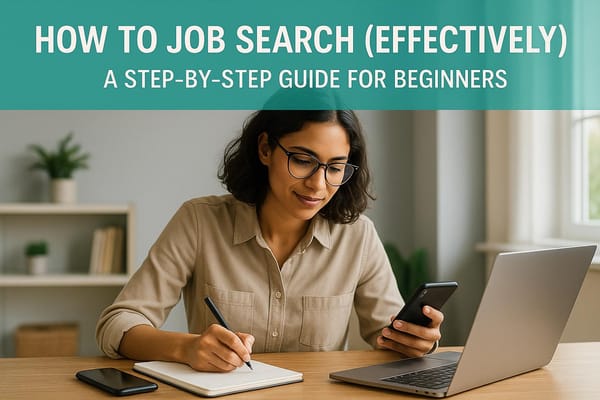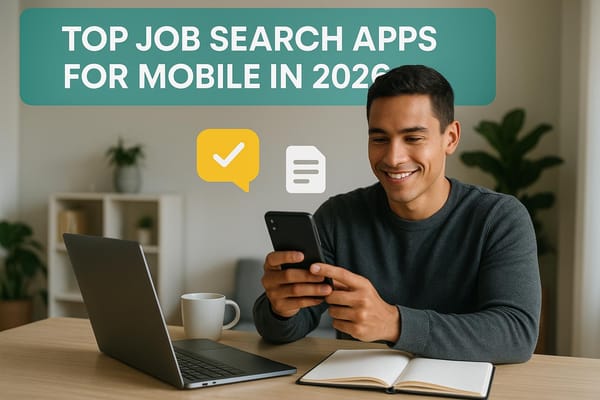How to Track Job Applications on LinkedIn
Learn how to efficiently track job applications on LinkedIn to enhance your job search and increase interview opportunities.

Tracking your job applications on LinkedIn can save you time, reduce stress, and improve your chances of landing interviews. Here's how to do it:
- Use LinkedIn's "My Jobs" Dashboard: Access all your applications in one place. Sort them by date, company, or job title for easy management.
- Track Application Status: LinkedIn shows updates like Applied, Viewed, Interviewed, or Not Selected to help you plan your next steps.
- Set Job Alerts: Create up to 50 alerts for new openings. Fine-tune filters by job title, location, or posting time.
- Follow-Up Timeline: Check back 7-10 days after applying, then follow up again at 14 and 21 days to stay top of mind with employers.
- External Tools: Use apps like Teal HQ, Huntr, or Scale.jobs for advanced tracking and cross-platform integration.
How To See Jobs You Applied For On LinkedIn
LinkedIn's Job Application Tracking Features
LinkedIn offers a built-in tracking system to help you manage your job applications from a single dashboard. This tool makes it easier to oversee multiple applications and stay updated on their progress.
Finding the Jobs Section
Checking your application history on LinkedIn is simple. On desktop, click the "Jobs" tab in the top navigation, then choose "My Jobs" from the left panel, and open the "Applications" folder. For mobile users, go to Profile > View Profile > 'Open to work' card > Show all applications.
Sorting Your Applications
LinkedIn automatically lists your applications in reverse chronological order but allows you to sort them differently to better suit your needs. Here are the sorting options:
| Sort Option | Purpose |
|---|---|
| Date Applied | Track your most recent submissions |
| Company Name | Follow up with specific organizations |
| Job Title | Monitor applications for similar roles |
Reading Application Status Updates
LinkedIn uses status indicators to show where your application stands:
- Applied (Blue): Submitted, but no action from the employer yet. Check back weekly.
- Viewed (Blue): Your profile has been opened. Consider sending a connection request to the hiring manager within 3-7 days [1].
- Interviewed (Green): You’ve advanced to interviews. Send a thank-you note within 24 hours.
- Not Selected (Gray): The position has been filled. Archive this application and focus on new opportunities.
"If status changes to 'Viewed,' send a connection request to the hiring manager. After 7 days in 'Viewed' status, share a portfolio sample related to the job to maintain engagement." [1]
Keep in mind, LinkedIn automatically tracks applications submitted via EasyApply, but for external applications, you’ll need to manually add them by clicking '+ Add' and entering the company and job details [4].
Focus on applications that have been in the 'Viewed' status for over 7 days by sharing relevant portfolio samples to stay on the employer’s radar [1].
Once you’ve got a handle on tracking, LinkedIn’s alert system can help you stay proactive - more on that in the next section.
Managing Alerts and Follow-ups
LinkedIn's alert system is a powerful tool to keep your job search organized and on track. By setting up alerts and following a structured schedule for follow-ups, you can improve your chances of landing interviews.
Setting Job Alerts
LinkedIn lets you create up to 50 active job alerts at once [4], keeping you informed about new opportunities as they arise. To make the most of these alerts, fine-tune them with precise settings:
| Alert Parameter | Recommended Setting | Why It Matters |
|---|---|---|
| Frequency | Daily | Ensures you're among the first to apply for competitive roles. |
| Search Filters | Use AND/OR combinations | Helps target specific criteria (e.g., "Product Manager" AND "Remote"). |
| Location Radius | 25-50 miles | Balances commute options with job availability. |
| Posted Timeline | Past 24-48 hours | Boosts your chances of a response by 30% [1]. |
To set up these alerts, go to the Jobs tab and click on "Job Alerts" in the sidebar. Use specific job titles and industry filters to ensure the alerts match your goals. For example, if you're in tech, you could create separate alerts for "Software Engineer" roles based on location or desired experience level [4].
"The first 48 hours after a job posting are critical. Data shows applicants who apply within this window have 30% higher response rates from employers" [1].
Planning Follow-up Times
A clear follow-up schedule helps you stay on top of your applications and maintain communication with potential employers. Here's a suggested timeline:
- First follow-up: 7-10 days after applying.
- Second follow-up: Around day 14.
- Final check-in: By day 21.
- For urgent roles, shorten the intervals by 25% [1].
Here’s a simple follow-up template:
"Dear [Name], I remain interested in [Position] given my experience with [Skill]. I'm available to discuss this week if convenient."
You can also use LinkedIn's calendar integration to track application dates and set automated reminders for follow-ups. These tools work seamlessly with LinkedIn's tracking system, giving you an efficient way to manage your job search.
Additional Application Tracking Tools
LinkedIn's built-in tracker is a good starting point, but if you're looking for more advanced features, these tools can help:
Job Search Extensions and Apps
Browser extensions like Simplify can automatically combine your LinkedIn applications with those from other platforms, giving you a more organized system. These tools work seamlessly with LinkedIn, helping you keep everything in one place.
| Tool Name | Key Features | Ideal For |
|---|---|---|
| Teal HQ | Resume analytics, LinkedIn integration | Job seekers who rely on data insights |
| JobTracker | Visual pipelines, deadline reminders | Applicants who prefer organized workflows |
| Huntr | Progress tracking, mobile-friendly | People who need tracking on the go |
Free Tracking Tools
If you're looking for no-cost solutions, there are options that still offer a lot of functionality.
For instance, Scale.jobs provides a free tracker that syncs with LinkedIn applications and offers additional tracking tools. Here's what you get:
| Feature | Benefit | Results |
|---|---|---|
| ATS Scoring | Helps refine your application materials | Increases pass rates by 75% |
| Cross-Platform Sync | Tracks applications from LinkedIn and other platforms | Lowers missed opportunities by 42% |
| Status Notifications | Provides real-time updates | Improves follow-up timing by 68% |
All of these tools comply with 2024 data protection standards, ensuring your LinkedIn data stays secure.
Job Application Support Services
For those applying to many jobs, services like Scale.jobs (priced at $4/hour) can streamline LinkedIn tracking with features such as:
| Service Feature | How It Benefits LinkedIn Integration |
|---|---|
| ATS-Optimized Resumes | Aligns resumes with LinkedIn job keywords |
| Automated Applications | Automatically updates application statuses |
| Document Management | Ensures consistency across materials |
| Follow-up System | Syncs with recruiter interactions |
One case study highlighted a user navigating visa requirements who landed three job offers in just 11 weeks using LinkedIn-integrated tracking - after struggling for eight months with manual applications.
Certain user groups have seen impressive results:
| User Type | Benefit from LinkedIn Integration |
|---|---|
| Graduates | 2.1x more interviews through profile-aligned applications |
| Career Changers | Job placement in 58 days with tracker-guided strategies |
| Visa Seekers | 37% faster document approvals |
These tools are especially effective when paired with LinkedIn's tracking system, helping users maintain consistent application quality even with a high volume of submissions.
Conclusion: Keys to Application Management
To get the most out of LinkedIn's tracking tools, pair them with these practical strategies:
Using LinkedIn's features alongside consistent routines can make a big difference. For example, professionals who spend 15 minutes daily on status updates, 30 minutes weekly reviewing their profiles, and 15 minutes monthly fine-tuning alerts see 40% higher response rates from recruiters [1].
Experts in career growth highlight the importance of follow-ups. A systematic approach to follow-ups leads to a 40% increase in employer responses compared to just one follow-up attempt [1]. By combining well-timed follow-ups with LinkedIn's status features, you can create a more organized and effective tracking system.
For those with specific needs, such as navigating visa requirements, LinkedIn's Company Pages are a goldmine. Researching employers' sponsorship histories can be a game-changer. Data shows that F-1 OPT candidates monitoring STEM Designated Employer listings have 92% higher success rates [1]. Similarly, H-1B transfer applicants benefit from paying attention to visa sponsorship details in job listings.
Another smart move? Update and resubmit applications after improving your LinkedIn profile. This simple step can boost callback rates by 33% [1]. When paired with LinkedIn's tracking tools, this approach makes application management much more effective.
Networking is another key piece of the puzzle. Job seekers who connect with at least five employees at their target companies see 50% faster hiring processes [1]. This highlights the advantage of blending data-driven tracking with relationship-building on LinkedIn.
"The combination of consistent tracking and strategic follow-ups has transformed our hiring timelines. Candidates who maintain organized application management typically progress through our pipeline 40% faster than those who don't", shares a tech recruitment-focused career coach [1].
For recent grads and career changers, LinkedIn-optimized applications and consistent tracking practices deliver strong results, proving how effective these methods can be.
FAQs
Here are answers to some common questions about using LinkedIn's tracking features effectively:
Can you see application status on LinkedIn?
Yes, you can. To check, go to Jobs > My Jobs > Applications. Around 58% of employers provide regular updates on application statuses, with tech companies leading at 82% [1][2]. It's best to review your status every 3-5 business days since most updates happen within 7-14 days [1][3]. If you're applying during busy hiring periods or for urgent roles, consider checking every 48 hours [4].
What does the status of LinkedIn job application mean?
The status updates on LinkedIn show where your application stands in the hiring process. For most roles, checking every 3-7 days is sufficient, but during peak hiring seasons, you might want to check more often [1][3]. Updates are usually made within the first two weeks after you submit your application [4].
How do I know if my application went through on LinkedIn?
There are a couple of ways to confirm:
- Easy Apply: You'll get an instant confirmation within the app.
- Standard Applications: Look for an email confirmation and check the My Jobs section [1][4].
To stay on top of updates, check your application status during the company's working hours based on their time zone [4][5]. If you're dealing with visa deadlines or other time-sensitive matters, tools like Scale.jobs' free tracker (mentioned in the Target Users section) can help streamline your tracking.




